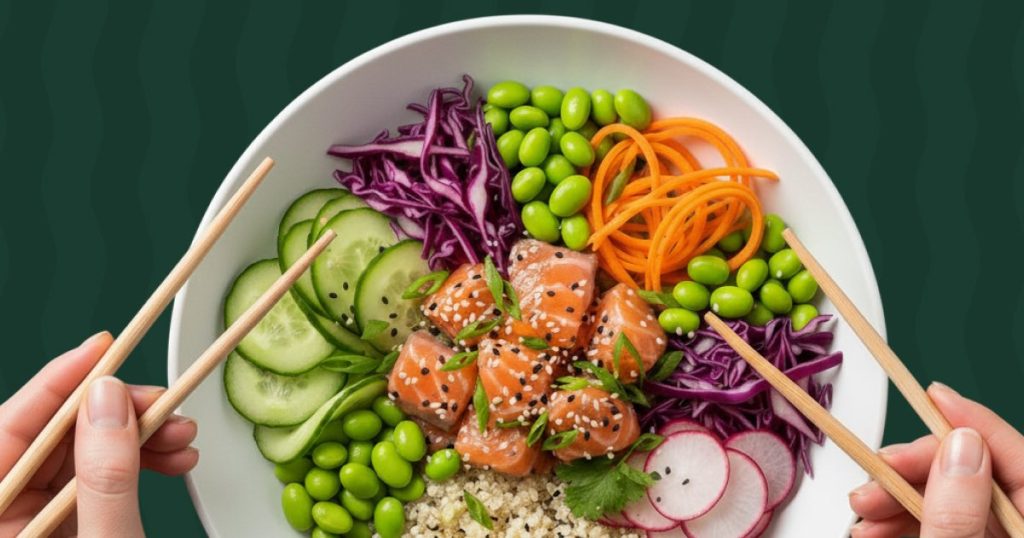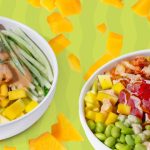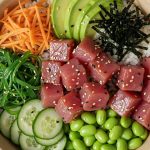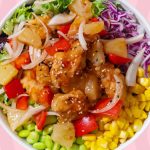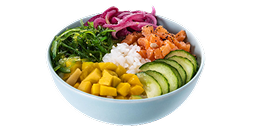The rise of the poké bowl has made it the default choice for the health-conscious lunch crowd. It’s colorful, customizable, and seems like the perfect guilt-free meal. But, does this vibrant Hawaiian-inspired dish genuinely support your weight loss goals?
The answer, like the bowl itself, lies entirely in the customization.
The great news is that a smartly built poké bowl is a powerful tool for dieting. Its key benefits are high protein and fiber, which are proven to promote satiety and prevent overeating. A properly structured bowl can deliver a full, nutritious meal for around 500 calories or less.
To maximize the benefits of poké for your diet, you need to make intentional choices in three key areas: The base, the protein, and the toppings/sauces.
This guide will break down the simple swaps that ensure your meal stays lean, nutritious, and perfectly aligned with your weight loss journey.
The Base Swap
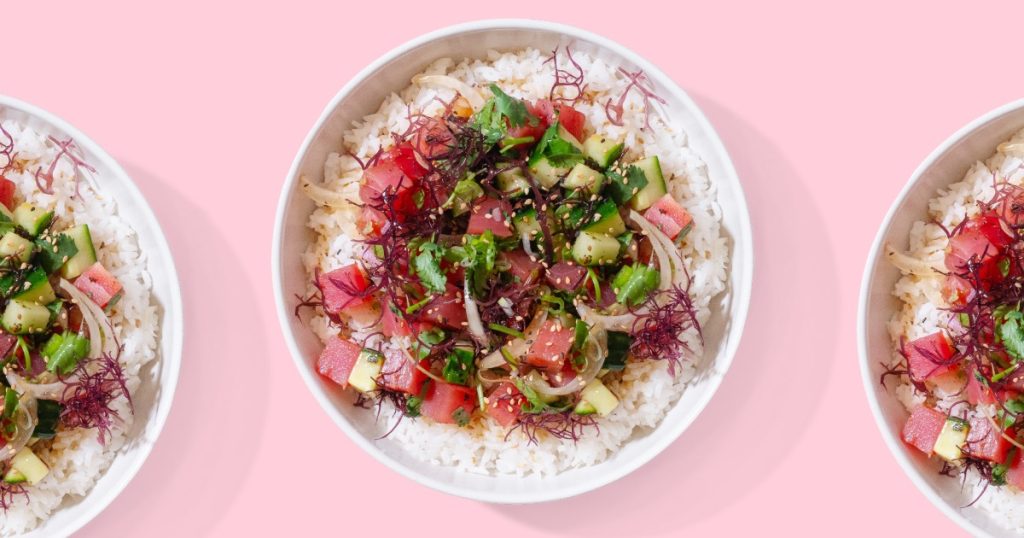
The base is the single most important decision you can make for a weight-loss-friendly poké bowl. This is where most of your carbohydrates and calories come from, but it’s also your greatest opportunity to boost fiber volume and cut back on total calories.
The Go-To Low-Calorie Champion: Mixed Greens
If your main goal is reducing calories and carbohydrates, skip the rice entirely and choose a vegetable base, like spring mix, shredded cabbage, or kale. Choosing mixed greens instead of one cup of white rice can instantly reduce your calorie count by up to 195 calories. This simple swap adds bulk, fiber, and micronutrients to your meal without adding significant calories.
The High-Protein Carb: Quinoa
For those needing a sustained energy boost or looking for a gluten-free base, quinoa is the smartest swap:
- The Advantage: Quinoa is naturally high in protein and fiber, making it a lower Glycemic Index (GI) option than white rice.
- Benefit: Its complex carbohydrate structure provides sustained energy and significantly enhances satiety, helping you feel fuller for longer.
The Best Traditional Carb: Brown Rice
If you prefer the familiar feel of rice, opt for its whole-grain cousin. Unlike highly processed white rice, brown rice is a whole grain packed with fiber. This makes it a more nutrient-dense option that supports stable blood sugar levels.
The Carb to Watch: White/Sushi Rice
- The Issue: White rice and traditional sticky sushi rice are fine in moderation, but they are low in fiber. In large volumes, they can spike your calorie and carb intake quickly.
- Pro Tip: If you want rice but are watching your carb intake, ask for a half-and-half base: half rice and half mixed greens. This gives you the desired taste and texture while keeping your calories in check.
The Protein Advantage
Protein is the cornerstone of any weight loss diet. It requires more energy for your body to digest than fat or carbs, which helps boost your metabolism. More importantly, high-quality, lean protein is crucial for satiety, keeping you feeling full for hours and minimizing cravings.
The Leanest Choice: Ahi Tuna
If keeping calories and total fat to an absolute minimum is your priority, Ahi Tuna is the winner. Tuna is exceptionally lean, providing a dense source of protein with significantly fewer calories and less fat per 4-oz serving compared to other proteins. It’s a powerful muscle-supporting meal without the fat load.
The Healthy Fat Trade-off: Salmon
While slightly higher in calories and fat than tuna, Salmon offers a major nutritional benefit that makes it a worthwhile choice for a balanced diet:
- Omega-3 Powerhouse: Salmon is loaded with Omega-3 fatty acids. These are essential, heart-healthy fats that can reduce inflammation, support brain function, and also contribute to that crucial feeling of fullness. If you view your poké bowl as a nutrient-dense, overall wellness meal, salmon is an excellent pick.
Plant & Cooked Options: Tofu, Chicken, and Shrimp
For those avoiding raw fish or simply looking for the lowest saturated fat options, the cooked and plant-based proteins are equally beneficial for dieting:
- Tofu: This plant-based option is a powerhouse of high-quality protein and is naturally low in saturated fat. Tofu is also brilliant because its neutral flavor means it soaks up the marinade beautifully, delivering maximum taste without added fat.
- Cooked Chicken or Shrimp: Choosing grilled chicken breast or light shrimp provides a protein-rich option that is low in fat, simple, and satisfying.
Avoiding the Calorie Culprits
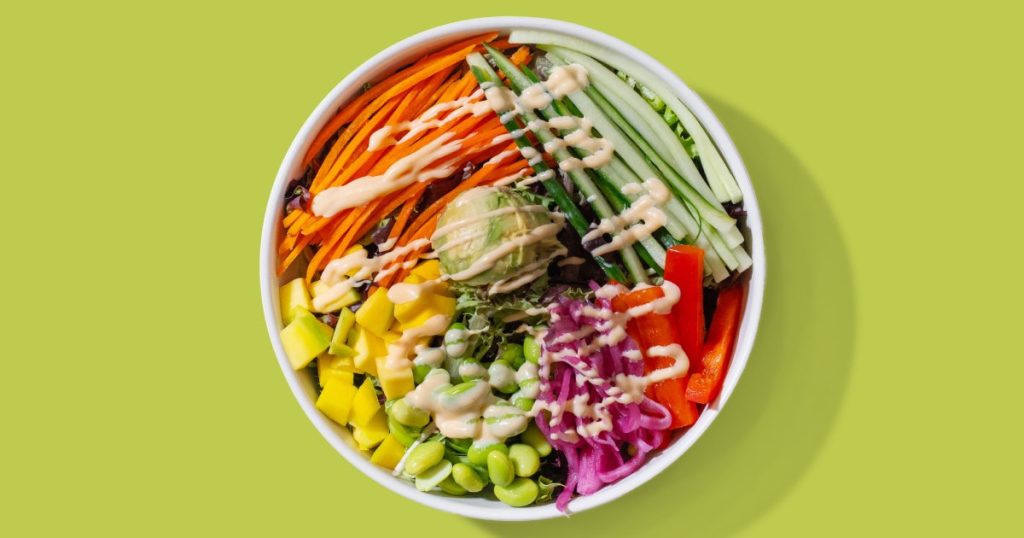
You’ve made smart choices on your base and protein, now don’t sabotage your bowl at the finish line! The final two steps, sauces and crunchy toppings, are where the vast majority of hidden calories, sugar, and unhealthy fats found. These small additions can easily push a 400-calorie bowl past 800 calories.
Creamy Sauces
The sauce is often the single biggest threat to a low-calorie poké bowl. A light-looking drizzle can be a heavy dose of fat and sugar.
- The Red Light: Stay away from creamy, mayo-based sauces like Spicy Mayo, Creamy Aioli, or Sweet Eel Sauce. These are the primary “calorie bombs,” high in oil, refined fats, and often sugar. A single generous serving can add over 200 calories.
- The Green Light: Opt for clear, lighter sauces such as Ponzu, Shoyu, or Traditional Hawaiian Sauce. These vinegar or soy-based sauces provide bold flavor with minimal fat. Always ask for sauces on the side and use sparingly to control sodium and sugar.
Toppings
Texture is essential for a satisfying meal, but you need to swap the deep-fried crunch for a natural one.
- The Saboteurs: Avoid deep-fried toppings like Tempura Flakes, Crispy Onions, or Fried Wontons. These contain significant oil and add up to 80 calories or more per small serving, with zero nutritional value.
- The Smart Crunch: Get your texture from healthy options like Edamame, Cucumber, Shredded Nori, or Pickled Ginger. These boost fiber, vitamins, and minerals with a minimal caloric impact.
- The Healthy Fat to Limit: Avocado & Nuts. While ingredients like Avocado and Macadamia Nuts are incredibly healthy, rich in fiber and monounsaturated fats, they are also extremely calorie-dense. If you’ve chosen, ask for less avocado, or vice versa, to keep your overall fat calories in balance.
Conclusion
So, does a poké bowl help with weight loss? Yes, absolutely, when you build it right.
The poké bowl is one of the most flexible and diet-friendly meals available because it puts you in complete control. You can create a high-satiety, nutrient-dense meal by focusing on three simple rules. First, maximize your base: swap your rice for Mixed Greens or Quinoa to drastically cut calories and boost fiber. Second, choose lean protein: opt for Ahi Tuna or Tofu to maximize protein intake with minimal fat. Finally, skip the saboteurs: go light on or avoid entirely the creamy sauces like spicy mayo and fried toppings such as tempura flakes.
You now have the exact knowledge needed to transform a potential calorie bomb into a perfectly balanced, guilt-free meal.
Ready to build your ultimate low-calorie poké bowl? Stop by Olu Olu Poké today and put these tips into practice!
FAQs
1. How many calories are in a typical healthy poké bowl?
A healthy, customized poké bowl built with a base of mixed greens or half-rice/half-greens, lean protein, and light sauce can generally be kept between 400 to 550 calories.
2. Which base is the lowest in calories for a poké bowl?
Mixed greens or shredded cabbage are the lowest-calorie bases, as they can save you up to 195 calories compared to a full serving of white rice.
3. Is salmon or tuna better for weight loss?
Ahi Tuna is generally leaner and lower in overall calories. However, Salmon provides more heart-healthy Omega-3 fatty acids, which can also help keep you full. Both are great, high-protein choices.
4. What sauces should I avoid if I’m counting calories?
Avoid creamy, mayo-based sauces like Spicy Mayo or Aioli. Always opt for clear, lighter options like Ponzu or Shoyu and ask for them on the side to control the portion.
5. Can I still eat avocado when dieting?
Yes, but be mindful of the portion. Avocado is high in healthy fats and fiber, but it is very calorie-dense. To keep your bowl lean, consider asking for a smaller portion or skipping it if you’ve already chosen a fattier protein like salmon.
